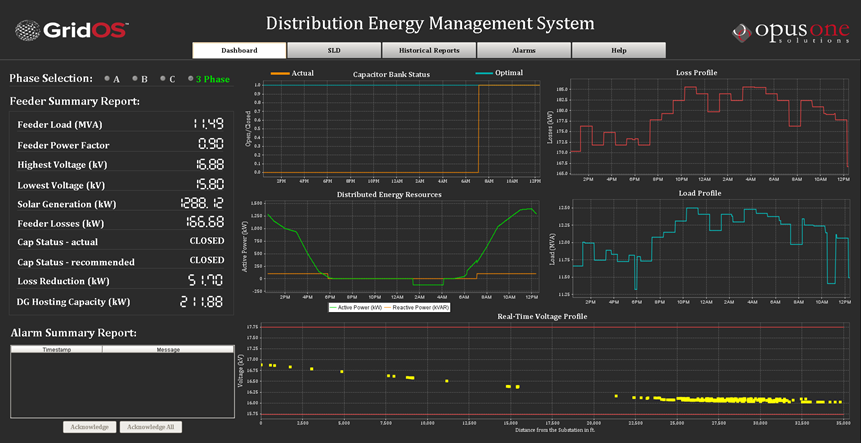Integrated Urban Community Energy Project
Lead Proponent: Opus One Solutions Energy Corporation
Location: Toronto, ON
ecoEII Contribution: $ 5,317,600
Project Total: $ 12,656,350
Project Description
The integration of renewable energy sources into the grid has many important economic and environmental benefits for Canadians, and therefore, electricity generation from these sources has increased dramatically. However, renewable energy sources are typically distributed and variable, putting significant pressure on an electrical grid that was designed decades ago to handle large, dispatchable generators. Moreover, increasing numbers of electric vehicles on distribution networks will put additional stress on the grid. Smart grid technologies enable more effective management of modern electrical grids and facilitate the integration of renewable energy sources and intermittent loads.
Opus One Solutions is a Toronto-based software engineering and solutions company with expertise in advancing innovation for the modern grid. Recognizing the challenges on the grid posed by distributed and variable sources and loads, the company proposed the project “Integrated Urban Community Energy Project” for ecoEII funding. The Project was awarded $5.3M to develop and demonstrate the “smartness” of the grid through four key innovations: distribution system energy management, advanced sensing and control infrastructure, interoperability architecture, and distributed and networked intelligence.
Results

Screenshot of GridOS® Distribution Energy Management System dashboard showing feeder summary report, alarm summary report and graphs indicating loss profile, load profile, distributed energy resources, capacitor bank status, real-time voltage profile.
Opus One designed, installed and commissioned a full-scale microgrid for the Athletes’ Village at the 2015 Pan Am Games, in partnership with Siemens, eCAMION, University of Toronto and Toronto Hydro. The microgrid consisted of a 100kVA/125kWh grid-scale lithium ion battery storage system, 3kW of rooftop mounted translucent-cell solar photovoltaic system, six Level 2 electric vehicle (EV) charging stations and one Level 3 DC Fast Charging station, all connected to Toronto Hydro’s distribution grid and controlled by Opus One’s GridOS®. Furthermore, a parallel microgrid was installed at Opus One’s facilities – the Intelligence and Integration Centre of Excellence (IICE) serves as a living lab and showcase for advancing microgrid controllers and the management of distributed energy resources.
GridOS® is a real-time intelligent energy networking software platform for multi-sided (distributed energy resources, utility, and independent system operator) management and optimization of the distribution network. It is a “model-based” system that uses the three-phase alternating current unbalanced model of the distribution network and sophisticated real-time optimal state estimation algorithms for all of its real-time (seconds to <1 min) decision making. GridOS provides distribution system energy management capabilities for real time control of generation, storage and demand resources (including EV charging). An advanced sensing and control infrastructure (ASCI) enables grid operators to enhance their situational awareness and optimize system performance through the use of smart sensors, controls and diagnostic tools. GridOS also implements an interoperability architecture that provides local translation of all access network points to create a common “grid service bus” (a unified information and intelligence backbone, and platform for seamless interoperability). Moreover, GridOS facilitates the decentralization of intelligence from the utility enterprise network further down the distribution system, through the use of adaptive controllers to create “intelligent nodes”. Each node is coupled to an energy resource (e.g. generation, storage, or demand resource), and its operation with the smart grid (including intermittency, volt/var, and power quality) may be controlled independently.

Demonstration site - Cherry Street YMCA in downtown Toronto, one of six buildings within 2015 Pan American Games Athletes' Village
The Athletes’ Village microgrid ran a Time-Of-Use (TOU) scheme and islanding protection strategy. If there was a grid outage, the system would remove itself from the grid while sustaining the charging of up to 7 vehicles. Control devices would switch from being grid powered to battery powered. An uninterruptable power supply (UPS) offered the last line of defense should the batteries run out. Once the grid restored stability, the system would synchronize automatically, bringing the microgrid back into grid-connected state.
Benefits to Canada
The Project contributed to the core conceptualization, design, development and demonstration of the GridOS technology (specifically in real-time grid modelling and state estimation) which has the potential to significantly advance the “smartness” of the grid and facilitate the integration of renewable energy sources and intermittent loads.
Next Steps
Following project completion, the daily operation of the Pan AM microgrid was handed over to the YMCA with ongoing monitoring, support and maintenance by Opus One for five years thereafter. Opus One continues to deploy GridOS with other projects while developing further functionality of the software platform.
Page details
- Date modified: